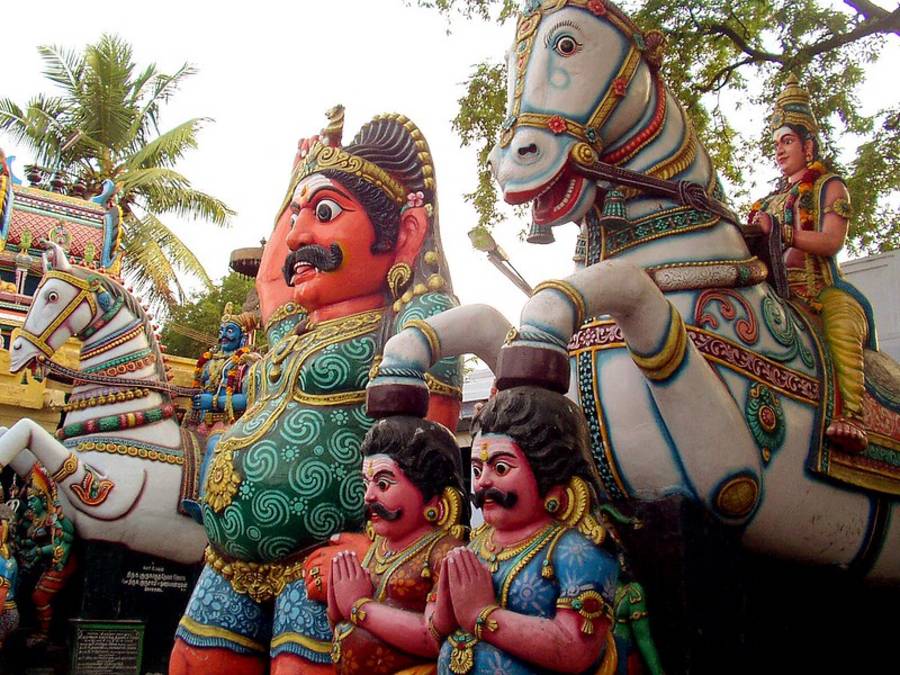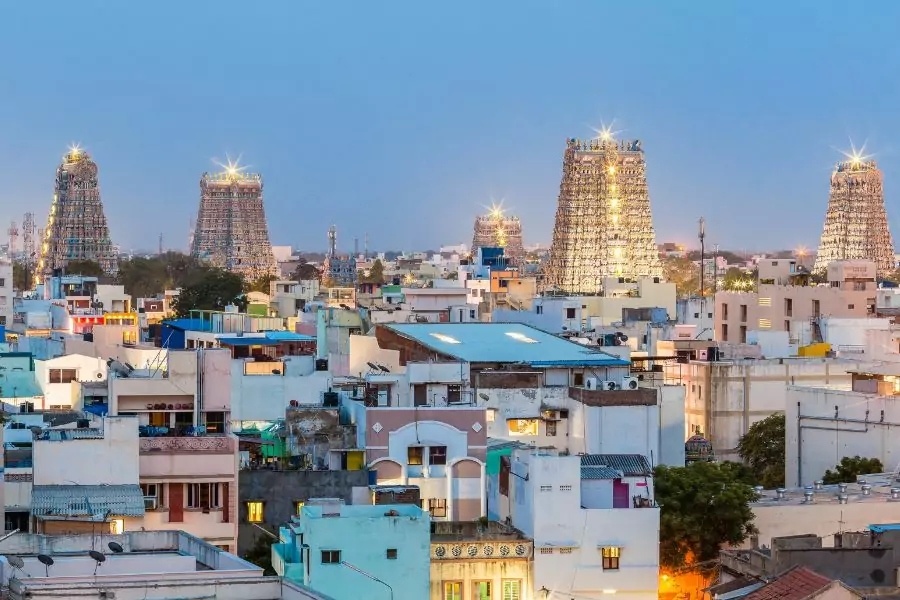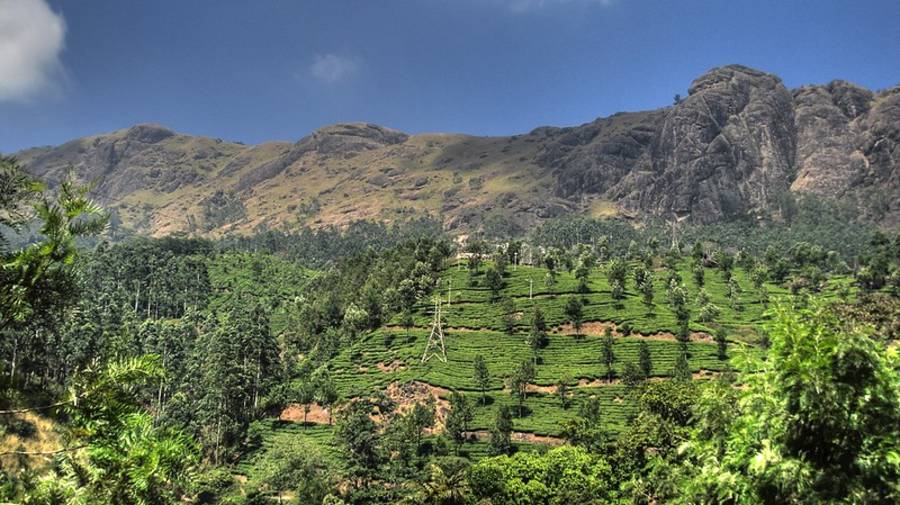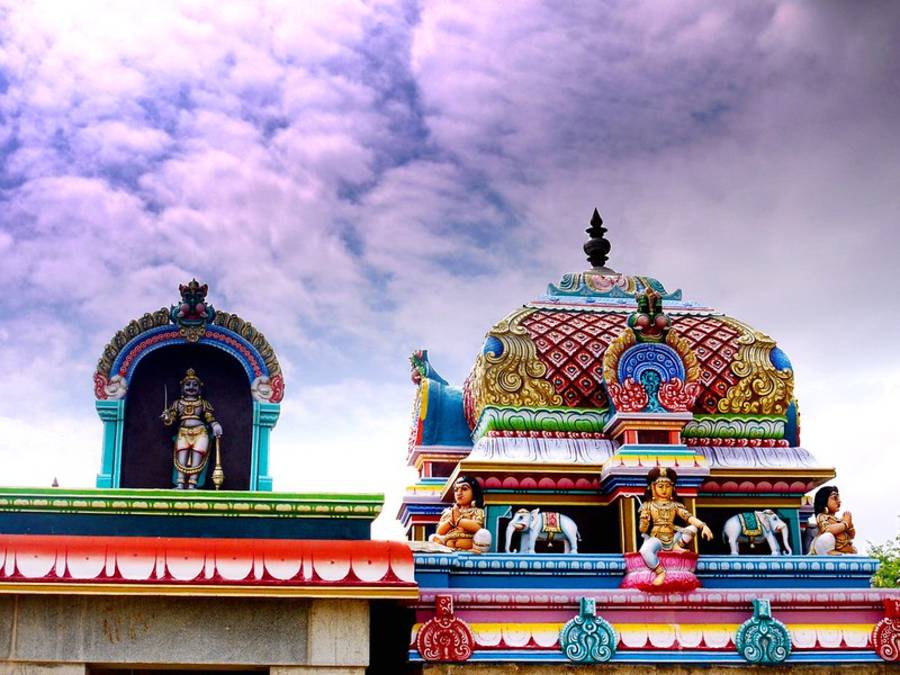Ayyanar Temple
Fortunately, our Tamil native driver knew the way along back roads to this location whose name, if any, has been worn clean from decades of weather. Immediately we were in sight of more than 1000 terracotta horses that line the drive. The horses are offerings to the Ayyanar. In South India, particularly Tamil Nadu, the Hindu village god Ayyanar is a popularly worshiped deity. He is known as the protector of rural villages and interestingly, the priests are usually non-Brahmins. Beginning from the dusty village road, the horses continue on past trees and shrubs for several minutes where it finally deposits visitors in a dead end. Located several kilometers from the villages of Chettinad, a region in Central Tamil Nadu known for its pottery, tilework, and unique spicy foods, lies an Ayyanar temple. To say this destination is a temple that doesn’t fit the traditional model of what tourists come to expect. Nor the rules of Hinduism. Vedic laws state a complete temple must have a roof and finial in order to house the essence of the gods. Yet upon arrival, my travel partner and I discovered one of the most fascinating, spiritual, and peaceful sights to date.
The population of predominantly potter caste villagers has worshiped Ayyanar since ancient times. Their religion, although Hindu, exists more as a clan-based worship system. Temples are generally found on the edges of villages, free from the usual monumental buildings found around South India. As village life revolves around nature and community, so too does worship which takes place in open grounds near trees and stresses the importance of family life. Ayyanar worship represents a non-learned, non-Vedic form of worship. Often community life and family values are more valued than individualist life mode.
Two young kids, one boy, and one girl, met my travel partner and me as we walked past the painted bodies of full, partial, and crumbled horses. Asking for pens or chocolate, the kids became unofficial tour guides. Unfortunately, they knew very few other English words so we had to rely on hand gestures and facial movements as simple ways to communicate. Initially, we were both frustrated by the children’s attendance. Up to this point, we were walking quietly in our thoughts with little conversation between ourselves. Once the kids arrived, their loud voices and behavior, as if they had traveled this path thousands of times for other tourists, numbed them from appreciating our desire to see this sight in peace.

“Shoes, Shoes!” they exclaimed as my travel bud and I passed the elephant carvings so well known by Ayyanarianfollwers. We had now reached the inner sanctum of the outdoor temple. No markings, no signs of any kind would have alerted us to our location. A few steps further into the dead-end square before us lied a strip of various small clay idols and figures. Behind that, lies a graveyard of broken clay shards and finally, the thick trunk of a tree whose branches provided the shade to gather here even in the hottest of sun-soaked days. The young girl pulled an art plate from behind a short wall offering us the symbolic tilak. Although we were inside the temple, I didn’t feel we were paying proper respects or performing puja. With that thought, I waved her off without my mark.
The four of us were alone. Our visit in the late afternoon didn’t correspond with the village life of chores and jobs. Where these kids belonged, and to whom, was a mystery. The serene settings and significance made us want to stay longer. Our new-found friends stuck closely to us clinging to their hopes of some offers. As we slipped on our shoes and made our way back to the car leisurely, coins clanged together in their miniature palms. Both examined the shiny metal tokens we had handed them while offering the best smiles this hard, village life would afford them. Back at the car, our faithful driver Selvam was swarming with elderly beggars who had seen the tourist number plates and chance to earn spare change.
History
The origin of Ayyanar worship is shrouded in myth and legend, and there are various stories associated with the deity’s origin and powers. Some believe that Ayyanar was a historical figure who lived during the Sangam era, a period of Tamil literature and culture dating back to the 3rd century BCE. According to this belief, Ayyanar was a warrior who protected the people and their land from enemies and wild animals.
Another legend associated with Ayyanar’s origin is that he was a manifestation of Lord Shiva, who took the form of a guardian god to protect the people from demons and evil spirits. Some also associate Ayyanar with the ancient Tamil deity Aiyanar, who was worshiped by the people of the Pandya kingdom.
Over time, Ayyanar worship became popular among the rural communities of South India, especially among the farming and pastoral communities who relied on the land for their livelihood. Ayyanar temples were built in villages and the countryside to invoke the deity’s protection and blessings for a good harvest, good health, and general well-being.
The Ayyanar worship practices have evolved over time, incorporating elements of local traditions and customs. The deity’s association with horses, dogs, and other animals is believed to have been influenced by the pastoral lifestyle of the people. The animal sacrifices associated with Ayyanar worship were also believed to be a way to appease the deity and protect the village from harm.
Today, Ayyanar worship continues to be an integral part of the rural culture of South India, with many temples dedicated to the deity and devotees seeking his blessings for protection and prosperity.
Things to do
If you are visiting an Ayyanar temple, there are several things you can do to experience the rich culture and traditions associated with this folk deity:
- Offer prayers and make offerings: Like in most Hindu temples, offering prayers and making offerings to the deity is an essential part of Ayyanar worship. You can offer flowers, fruits, and other items to the deity and seek his blessings for protection, prosperity, and well-being.
- Participate in the rituals: Ayyanar worship has several unique rituals and customs that differ from mainstream Hindu practices. You can participate in these rituals, such as the lighting of lamps, chanting of hymns, and the offering of animal sacrifices (if permitted and acceptable to you), to experience the cultural richness and spiritual significance of the Ayyanar worship.
- Explore the temple architecture: Ayyanar temples have a unique architecture that reflects the deity’s association with the rural and agrarian way of life. You can explore the temple complex and admire the stone carvings and sculptures that adorn the temple walls and pillars.
- Learn about the deity’s history and mythology: Ayyanar worship has a rich history and mythology associated with the deity. You can learn about the various legends and stories associated with Ayyanar’s origin and powers from the local priests and devotees.
- Experience the local culture: Ayyanar temples are often located in rural areas, where you can experience the local culture and traditions of the people. You can interact with the local people, taste the local cuisine, and learn about the traditional arts and crafts of the region.
It is important to respect the local customs and traditions when visiting an Ayyanar temple and to follow the temple’s rules and regulations.
Places to visit around Ayyanar Temple
If you are visiting an Ayyanar Temple, there are several interesting places nearby that you can explore. Here are a few suggestions:
Thekkady:

Thekkady is a popular tourist destination located in the Idukki district of Kerala, known for its lush forests, wildlife, and spices. It is home to the Periyar National Park, which is a popular wildlife sanctuary and a great place to spot elephants, tigers, and other animals in their natural habitat.
Madurai:

Madurai is a historic city in Tamil Nadu known for its ancient temples, architecture, and culture. It is home to the famous Meenakshi Temple, which is a must-visit for its intricate carvings, sculptures, and colorful gopurams (towers).
Kodaikanal:

Kodaikanal is a scenic hill station located in Tamil Nadu, known for its natural beauty and pleasant weather. It is a popular destination for trekking, boating, and sightseeing, with several waterfalls, lakes, and viewpoints to explore.
Munnar:

Munnar is another popular hill station located in Kerala, known for its tea plantations, scenic vistas, and cool climate. It is a great place to relax, unwind, and enjoy nature at its best.
Hampi:

Hampi is a UNESCO World Heritage Site located in Karnataka, known for its ancient ruins, temples, and architecture. It was once the capital of the Vijayanagara Empire and has several impressive structures like the Virupaksha Temple, the Vittala Temple, and the Elephant Stables.
These are just a few of the many interesting places that you can visit around an Ayyanar Temple. The South Indian states of Tamil Nadu, Kerala, and Karnataka have several other tourist destinations worth exploring, each with its own unique culture, history, and attractions.
How to reach
The accessibility of an Ayyanar temple depends on its location. However, most Ayyanar temples are located in rural areas and may not be well-connected by public transportation. Here are some general guidelines for reaching an Ayyanar temple:
- By Road: The easiest way to reach an Ayyanar temple is by road. You can hire a taxi or take a local bus to the nearest town or village and then hire a local vehicle to reach the temple.
- By Train: If you are traveling from a distant city, you can take a train to the nearest railway station and then take a taxi or local transportation to reach the temple. Depending on the location of the temple, the nearest railway station could be in a different town or city.
- By Air: If you are traveling from a distant city or country, you can take a flight to the nearest airport and then take a taxi or local transportation to reach the temple. Depending on the location of the temple, the nearest airport could be in a different town or city.
It is important to note that the roads leading to some Ayyanar temples may not be well-maintained or well-lit, and may not be suitable for driving at night. It is also important to respect the local customs and traditions when visiting an Ayyanar temple, and dress modestly and appropriately.
FAQ
Here are some frequently asked questions about Ayyanar temples:
Who is Ayyanar?
Ayyanar is a folk deity worshipped in Tamil Nadu, Kerala, and parts of Karnataka. He is believed to be a powerful guardian deity who protects his devotees from harm and brings prosperity, peace, and well-being.
What is the significance of Ayyanar temples?
Ayyanar temples are considered sacred places where devotees seek the blessings of the deity. The temples are also important cultural and social centers that bring together people from different communities and promote local traditions and customs.
What are the unique features of Ayyanar temples?
Ayyanar temples have a unique architecture and design that reflects the deity’s association with rural life and agriculture. The temples often have elaborate stone carvings and sculptures, and are adorned with colorful flags and banners.
What are the rituals and customs associated with Ayyanar worship?
Ayyanar worship involves several unique rituals and customs, such as the lighting of lamps, the offering of flowers and fruits, and the sacrifice of animals (if permitted and acceptable to the devotee). The rituals are performed by the local priests and are accompanied by the chanting of hymns and the playing of music.
Can non-Hindus visit Ayyanar temples?
Yes, Ayyanar temples are open to people of all faiths and beliefs. However, it is important to respect the local customs and traditions, and follow the rules and regulations of the temple.
What is the best time to visit an Ayyanar temple?
Ayyanar temples are open throughout the year, but the best time to visit depends on the location and weather. It is best to avoid visiting during peak summer or monsoon season, as the roads leading to the temple may be difficult to access due to weather conditions.
Is photography allowed in Ayyanar temples?
Photography may be allowed in some Ayyanar temples, but it is best to ask for permission before taking photographs. It is important to respect the sanctity of the temple and avoid taking photographs of people or places without their consent.



